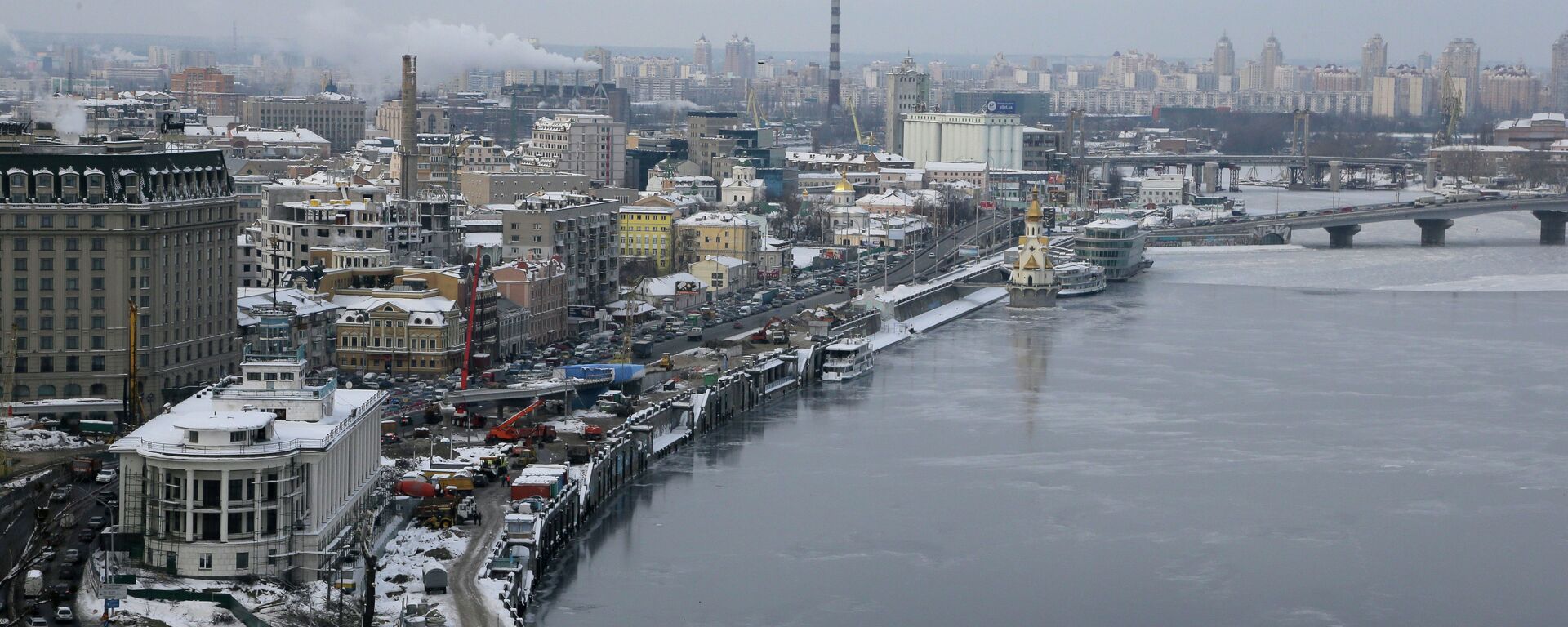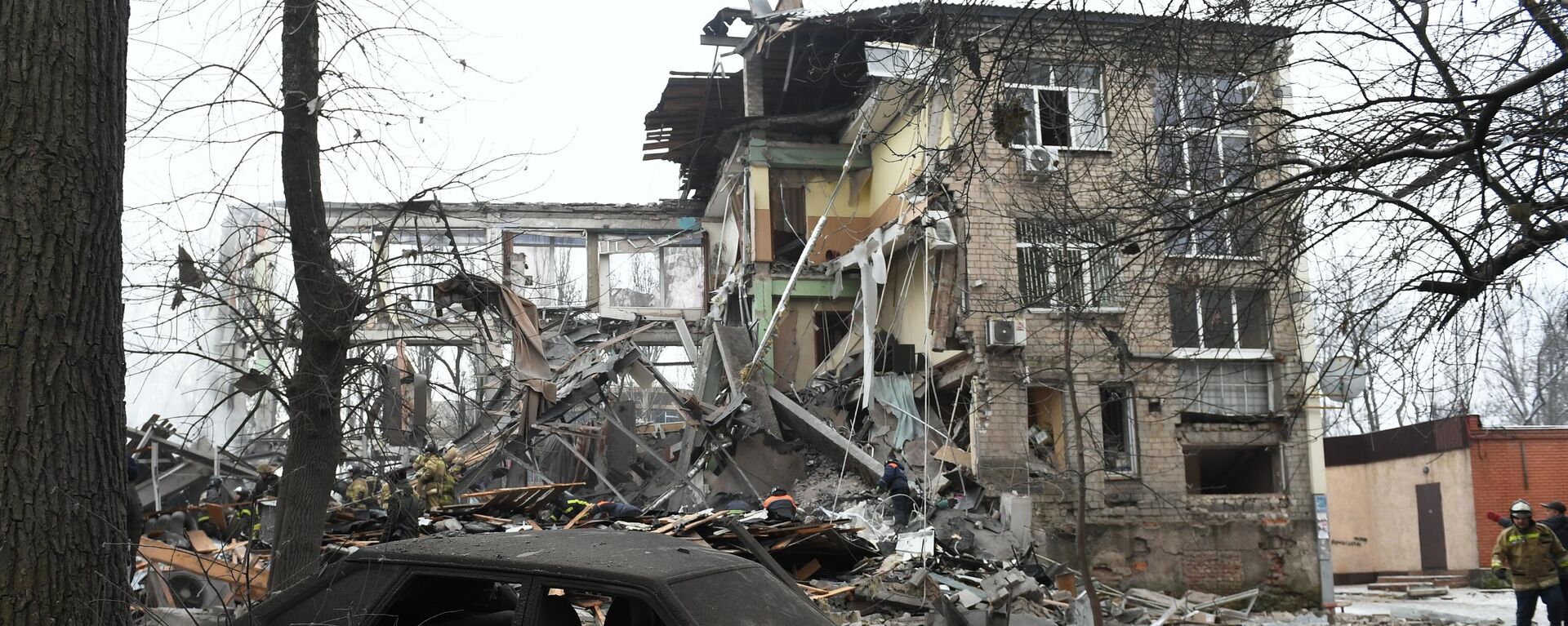https://sputnikglobe.com/20240101/west-worries-ukraine-wont-have-enough-air-defense-equipment-to-outlast-winter-1115933215.html
West Worries Ukraine Won’t Have Enough Air Defense Equipment to Outlast Winter
West Worries Ukraine Won’t Have Enough Air Defense Equipment to Outlast Winter
Sputnik International
Last week, the Russian military launched its largest drone, ballistic and cruise missile strikes in Ukraine since 2022, targeting energy infrastructure, military airfields, ports, HQs, fuel and ammo depots, with the attack overwhelming local air defenses. Kiev responded with terror strikes against the Russian cities of Belgorod and Donetsk.
2024-01-01T16:05+0000
2024-01-01T16:05+0000
2024-01-01T16:05+0000
russia's special operation in ukraine
grant shapps
military & intelligence
volodymyr zelensky
ukraine
kiev
russia
nato
raytheon
nasams
https://cdn1.img.sputnikglobe.com/img/07e7/05/18/1110571925_0:0:960:540_1920x0_80_0_0_5277299bc56541cb13b5ae8dafb677e6.jpg
Ukraine’s air defenses won’t be in a condition to repel Russian drone and missile attacks this winter due to a shortage of interceptor missiles for its NATO-provided air defenses. That’s the conclusion reached by military observers cited by British media.Pointing to the expected dearth of US military support for Kiev amid the ongoing battle in Congress over President Biden’s proposed $61 billion aid package, analysts warned that Ukraine’s air defenses may have to resort to rationing.Concerns are said to be particularly prescient in relation to the Patriot – the $1 billion Raytheon-made air defense and anti-missile system which the US sent to Kiev last spring, but which has had difficulties intercepting Russian projectiles and been targeted itself. After the Russian military’s massed missile and drone assault last Friday, an advisor to the Ukrainian Armed Forces’ Air Force Command conceded that Ukraine’s NATO-sourced air defenses have never actually managed to intercept even one of the estimated 300 Kh-22 series missiles Russian warplanes had launched into Ukraine since 2022.In comments regarding the AMRAAMs’ deliveries Friday, UK Defense Secretary Grant Shapps accused Russia of “testing Western resolve” in Ukraine with its campaign of precision strikes, and called on the “free world” to “come together and redouble our efforts to get Ukraine what they need to win.”These “efforts” are presumably on top of the estimated $200 billion Western taxpayers have already spent arming Kiev and funding its government, and the $205 billion EU countries have been forced to overpay for natural gas after unilaterally cutting off Russian energy deliveries.Western and Ukrainian intelligence officials indicated to UK media last week that Russia has spent months stockpiling missiles for winter strikes to overwhelm Ukrainian air defenses, undermine Kiev’s war effort and force the military to focus attention away from the front.Russia’s Defense Ministry has said that that unlike its Ukrainian counterpart, “the Russian Armed Forces strike only military facilities and infrastructure directly related to them.”Kiev responded to the December 29 Russian strikes with a campaign of terror bombings, targeting Belgorod – a city of 340,000 about 40 km from Kharkov with no military targets to speak of, and Donetsk, the Donbass city which has faced hundreds of thousands of Ukrainian missile, drone and artillery attacks going back to 2014.
https://sputnikglobe.com/20231227/us-announces-final-250-million-ukraine-aid-package-for-2023-1115839951.html
https://sputnikglobe.com/20240101/63-of-ukrainian-capitals-energy-infrastructure-damaged-destroyed-in-2023---kiev-authorities-1115924115.html
https://sputnikglobe.com/20240101/what-is-known-about-ukraines-shelling-of-donetsk-on-new-years-eve-1115927489.html
ukraine
kiev
russia
Sputnik International
feedback@sputniknews.com
+74956456601
MIA „Rossiya Segodnya“
2024
News
en_EN
Sputnik International
feedback@sputniknews.com
+74956456601
MIA „Rossiya Segodnya“
Sputnik International
feedback@sputniknews.com
+74956456601
MIA „Rossiya Segodnya“
is ukraine running out of air defense equipment amid russian missile strikes, why is russia targeting ukraine with long-range missile strikes
is ukraine running out of air defense equipment amid russian missile strikes, why is russia targeting ukraine with long-range missile strikes
West Worries Ukraine Won’t Have Enough Air Defense Equipment to Outlast Winter
Last week, the Russian military launched its largest drone, ballistic and cruise missile strikes in Ukraine since 2022, targeting energy infrastructure, military airfields, ports, HQs, fuel and ammo depots, with the attack overwhelming local air defenses. Kiev responded with terror strikes against the Russian cities of Belgorod and Donetsk.
Ukraine’s air defenses won’t be in a condition to repel Russian drone and missile attacks this winter due to a shortage of interceptor missiles for its NATO-provided air defenses. That’s the
conclusion reached by military observers cited by British media.
Pointing to the expected dearth of US military support for Kiev amid the
ongoing battle in Congress over President Biden’s proposed $61 billion aid package, analysts warned that Ukraine’s air defenses may have to resort to rationing.
“There will be some systems where they will have to ration their ammunition even more than they are at the moment,” Kiev-based defense analyst Jimmy Rushton said. “It could be a case that they have to just not engage some targets, because they don’t have enough interceptors to go around.”

27 December 2023, 20:53 GMT
“That’s obviously a horrible decision to have to make, but if you really believe that you’re running out of missiles to engage incoming targets, you’re going to have to ration them to protect the targets you believe to be most important,” the observer said.
Concerns are said to be particularly prescient in relation to the Patriot – the $1 billion Raytheon-made air defense and anti-missile system which the US sent to Kiev last spring, but which has had difficulties intercepting Russian projectiles and been targeted itself. After the Russian military’s massed missile and drone assault last Friday, an advisor to the Ukrainian Armed Forces’ Air Force Command
conceded that Ukraine’s NATO-sourced air defenses have never actually managed to intercept even one of the estimated 300
Kh-22 series missiles Russian warplanes had launched into Ukraine since 2022.
Amid dithering in Washington, London vowed to do its best to strengthen Ukraine’s air defenses last week through the provision of 200 Advanced Short Range Air-to-Air Missiles (AMRAAMs). The $1 million apiece Raytheon-made weapons are typically fitted to aircraft for aerial engagements, but can also be fired from the Norwegian-made Norwegian Advanced Surface-to-Air Missile System (NASAMS) and several US analogues. They have a range between 105 and 160 km. Kiev’s NATO backers are known to have given the country several NASAMS launchers and some missiles over the past year and a half.
In comments regarding the AMRAAMs’ deliveries Friday, UK Defense Secretary Grant Shapps accused Russia of “testing Western resolve” in Ukraine with its campaign of precision strikes, and called on the “free world” to “come together and redouble our efforts to get Ukraine what they need to win.”
These “efforts” are presumably on top of the estimated
$200 billion Western taxpayers have already spent arming Kiev and funding its government, and the
$205 billion EU countries have been forced to overpay for natural gas after unilaterally cutting off Russian energy deliveries.

1 January 2024, 01:53 GMT
Western and Ukrainian intelligence officials indicated to UK media last week that Russia has spent months stockpiling missiles for winter strikes to overwhelm Ukrainian air defenses, undermine Kiev’s war effort and force the military to focus attention away from the front.
“We are doing everything to strengthen our air shield. But the world needs to see that we need more support and strength to stop this terror,” Zelensky chief of staff Andriy Yermak said last week, referring to Russia’s strikes last week.
Russia’s Defense Ministry has said that that unlike its Ukrainian counterpart, “the Russian Armed Forces strike only military facilities and infrastructure directly related to them.”
Kiev responded to the December 29 Russian strikes with a campaign of terror bombings, targeting Belgorod – a city of 340,000 about 40 km from Kharkov with no military targets to speak of, and Donetsk, the Donbass city which has faced hundreds of thousands of Ukrainian missile, drone and artillery attacks going back to 2014.

1 January 2024, 09:57 GMT





